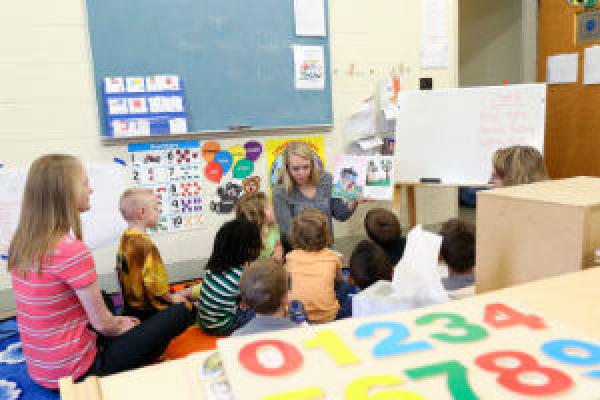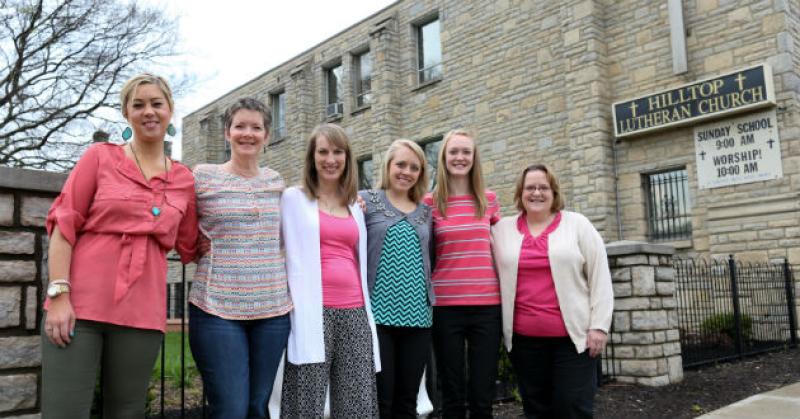Speech and Hearing Students Improve Pre-K Literacy Scores

Reading proficiency by the end of the third grade can be a make-or-break benchmark in a child’s educational development. Seventy-five percent of the students who are not reading at grade level in 3rd grade will remain poor readers in high school." — The Annie E. Casey Foundation
Hilltop Preschool
In the basement of the Hilltop Lutheran Church, you’ll find Hilltop Preschool, a non-profit organization offering free preschool to residents of the Hilltop area, on Columbus’ west side. Operated under Columbus Mayor Coleman's Early Start Columbus program, the school’s students and their families struggle – all of the children come from families who are below 125 percent of the poverty level.
The realities that Hilltop preschoolers face every day are daunting:
- 61% of the children have been identified with developmental delays;
- 40% live with a parent with a known substance abuse problem;
- 27% have a parent who has been incarcerated;
- 20% are learning English as a second language.
In October 2014, 67 percent of Hilltop Preschool students were assessed falling “below average” on the National Center for Learning Disabilities’ GET READY TO READ! screening tool, a national assessment for children in the year before they enter kindergarten, to determine whether they have the early literacy skills they need to become readers. Only 33 percent of the students achieved scores of “average” or “above average.
Laura Moehrman, executive director of Hilltop Preschool – now in its 7th year -- knew she had to do something. She also knew she had no money to hire a new teacher or specialist.
“I had the idea to submit a grant for a literacy program to the Ingram-White Castle Foundation (IWCF) because of their track record in supporting programs that help disadvantaged students achieve academic success,” said Moehrman. “I just didn’t have the second piece of puzzle figured out yet – who could provide the help.”
Fortunately, the preschool’s co-founder and board president, Jane Leach, and another board member Karen Carver, a speech pathologist, were familiar with the groundbreaking work in literacy intervention taking place at Ohio State’s Speech-Language Clinic. They encouraged Moehrman to give Ohio State a call.
“That phone call,” said Moehrman, “opened up a world of possibilities for our students, teachers and parents.”
“We were thrilled to get the opportunity to go out into the community,” said Gail Whitelaw, director of the Speech-Language-Hearing Clinic. “We (Ohio State’s Speech-Language-Hearing Clinic) would be the first clinic to be on-site, leading a pre-K early literacy intervention program.”

Ellen Bonk, licensed clinical supervisor and two graduate students from the clinic’s Speech Language Pathology MA Training Program — Breann Voytko and Kateyln Seitz — developed a series of weekly lessons plans specifically targeted to enhancing the following pre-literacy skills: segmenting and blending of sounds, syllables and words, rhyming, concepts of print, sequencing, narrative knowledge, comprehension, memory, problem-solution, character, setting and vocabulary.
Over the course of 11 weeks, from March through May 2015, Bonk, Voytko and Seitz spent every Tuesday and Friday, two hours per day, at Hilltop Preschool working with students, their teachers and staff on targeted literacy-based skills in the classrooms.
The intervention services provided by Bonk and the graduate students was informed by curriculum developed by Laura Justice, EHE Distinguished Professor, Ohio State’s College of Education and Human Ecology. The curriculum, Read It Again-PreK! is designed to develop and strengthen young children’s early foundations in language and literacy. It provides a systematic, explicit and flexible approach to building children’s skills, in four key areas of language and literacy: vocabulary, narrative, phonological awareness; and print knowledge
Chicka Chicka Boom Boom
Armed with copies of Giggle, Giggle, Quack; Clifford Goes to Dog; and Chicka Chicka Boom Boom, Bonk and her students gathered their “Bumblebees” and “Grasshoppers” into reading groups and started with the fundamentals.
“Concepts of print were targeted at the beginning of the reading sessions to reinforce and apply knowledge about titles, authors, illustrators and other aspects of the book,” explained Bonk. “Our intervention sessions focused on two themes: phonological awareness (e.g., syllables, rhyming, and first sounds) and ‘story sense’ concepts (e.g., character, setting, sequencing, major events, cause and effect).”
Having Bonk and her graduate students on site tripled student contact hours and increased the exposure to new skills for both Hilltop’s teachers and parents.
“Multiple exposures to consistent use of the same concept terms through a variety of activities are key in developing skills,” said Voytko. “Katelyn and I put together massive lesson plans with exercises around segmenting and blending of sounds (S sounds like snnnnake); syllables and words; rhyming (dog/fog); concepts of print; sequencing; narrative knowledge; comprehension; memory; problem-solution; character; setting and vocabulary.”
Literacy Scores on the Rise
At the conclusion of the 11-week intervention program, the preschoolers were tested to determine if their earlier literacy scores had changed.
The results?
“Eighty-nine percent (89%) of our students demonstrated higher literacy scores and 67 percent achieved “average” or “above average” on the GET READY TO READ! screening tool,” said Moehrman. “Those are simply remarkable statistics considering the many challenges we face.”
Students were not the only ones who benefited from the Ohio State partnership.
“Our teachers benefitted from the modeling of techniques for speech, language and literacy concepts provided by Ellen and her students,” said Moehrman. “And our parents were empowered with information and skills to support their young developing readers, through take home sheets, scripts, special family events and parent/teacher conferences,” said Moehrman.
Moehrman believes that Intervention is necessary to ensure that at-risk children learn at a quicker pace and to help fill the gap that exists between them and their national peers.
“We must seek out emerging research and innovative partnerships like Ohio State’s Speech- Language-Hearing Clinic’s literacy intervention program if our children are to thrive and succeed.”
For Whitelaw, being on site, working with teachers, families and students is critical to ensuring success of a literacy intervention program.
“It can no longer be a segregated effort –with clinicians and researchers confined to the academic world,” said Whitelaw. “We do our best work when we have everyone at the table —teachers, principals, schoolchildren and families — that is cutting-edge practice.”
The Partnership Continues
Both Whitelaw and Leach were thrilled with the test results when the pilot project was complete. The challenge now is to identify ways to continue bringing the best early education and literacy intervention to these at-risk children to ensure their success.
“We’re in the process of hiring new clinical faculty in speech/language pathology specifically to provide language and literacy support to Hilltop and other schools,” said Whitelaw. “We are committed to this partnership and seeing how we can improve and expand on our services.”
In the meantime, a group of undergraduate students in the Speech-Language-Hearing Clinic is doing its part to support the children, families and teachers at Hilltop Preschool. The students, all members of National Student Speech Language Hearing Association - NSSLHA - are building a library at the school.
For more information on the Ohio State Speech- Language-Hearing Clinic – Hilltop Preschool partnership, contact Gail Whitelaw, clinic director, at whitelaw.1@osu.edu.
